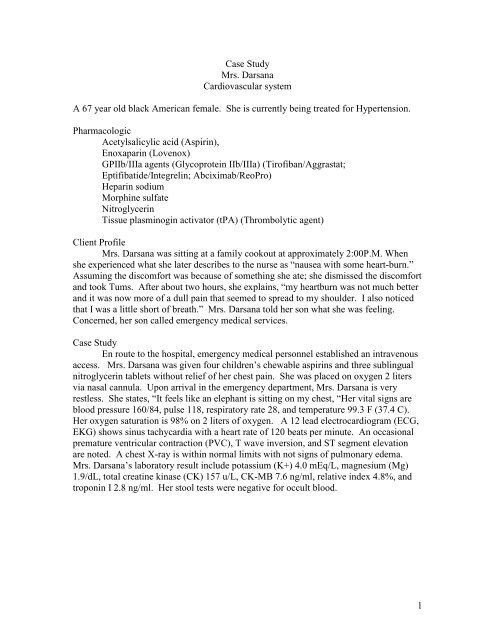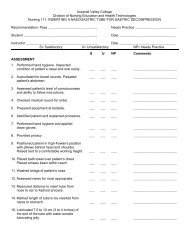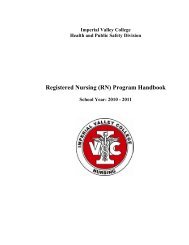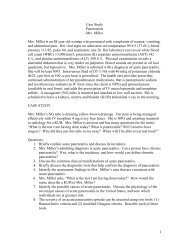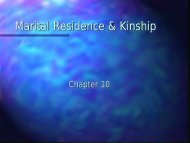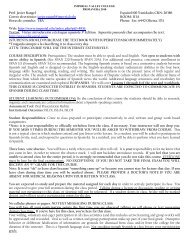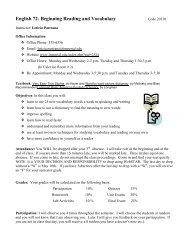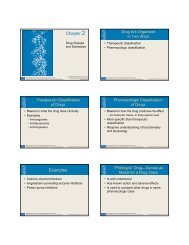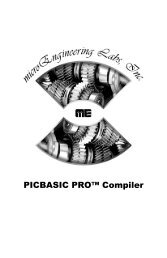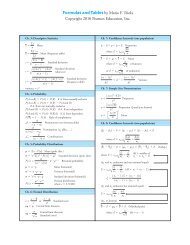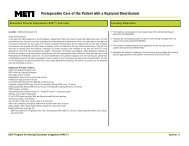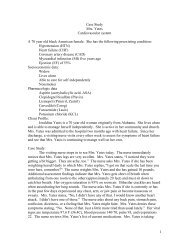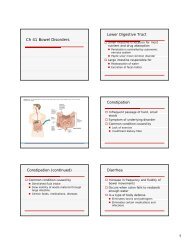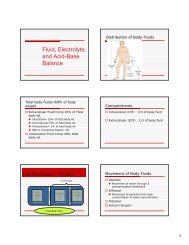Case Study MI Mrs Darsana.pdf
Case Study MI Mrs Darsana.pdf
Case Study MI Mrs Darsana.pdf
You also want an ePaper? Increase the reach of your titles
YUMPU automatically turns print PDFs into web optimized ePapers that Google loves.
<strong>Case</strong> <strong>Study</strong><strong>Mrs</strong>. <strong>Darsana</strong>Cardiovascular systemA 67 year old black American female. She is currently being treated for Hypertension.PharmacologicAcetylsalicylic acid (Aspirin),Enoxaparin (Lovenox)GPIIb/IIIa agents (Glycoprotein IIb/IIIa) (Tirofiban/Aggrastat;Eptifibatide/Integrelin; Abciximab/ReoPro)Heparin sodiumMorphine sulfateNitroglycerinTissue plasminogin activator (tPA) (Thrombolytic agent)Client Profile<strong>Mrs</strong>. <strong>Darsana</strong> was sitting at a family cookout at approximately 2:00P.M. Whenshe experienced what she later describes to the nurse as “nausea with some heart-burn.”Assuming the discomfort was because of something she ate; she dismissed the discomfortand took Tums. After about two hours, she explains, “my heartburn was not much betterand it was now more of a dull pain that seemed to spread to my shoulder. I also noticedthat I was a little short of breath.” <strong>Mrs</strong>. <strong>Darsana</strong> told her son what she was feeling.Concerned, her son called emergency medical services.<strong>Case</strong> <strong>Study</strong>En route to the hospital, emergency medical personnel established an intravenousaccess. <strong>Mrs</strong>. <strong>Darsana</strong> was given four children’s chewable aspirins and three sublingualnitroglycerin tablets without relief of her chest pain. She was placed on oxygen 2 litersvia nasal cannula. Upon arrival in the emergency department, <strong>Mrs</strong>. <strong>Darsana</strong> is veryrestless. She states, “It feels like an elephant is sitting on my chest, “Her vital signs areblood pressure 160/84, pulse 118, respiratory rate 28, and temperature 99.3 F (37.4 C).Her oxygen saturation is 98% on 2 liters of oxygen. A 12 lead electrocardiogram (ECG,EKG) shows sinus tachycardia with a heart rate of 120 beats per minute. An occasionalpremature ventricular contraction (PVC), T wave inversion, and ST segment elevationare noted. A chest X-ray is within normal limits with not signs of pulmonary edema.<strong>Mrs</strong>. <strong>Darsana</strong>’s laboratory result include potassium (K+) 4.0 mEq/L, magnesium (Mg)1.9/dL, total creatine kinase (CK) 157 u/L, CK-MB 7.6 ng/ml, relative index 4.8%, andtroponin I 2.8 ng/ml. Her stool tests were negative for occult blood.1
Questions:1. What are the components of the initial nursing assessment of <strong>Mrs</strong>. <strong>Darsana</strong> whenshe arrives in the emergency department?2. <strong>Mrs</strong>. <strong>Darsana</strong> has a history of unstable angina. Explain what this is?3. Briefly discuss what causes and <strong>MI</strong>,. Include in the discussion the other termsused for this diagnosis?4. The nurse listens to <strong>Mrs</strong>. <strong>Darsana</strong>’s heart sounds to see if S3,S4, or a murmur can be heard. What would the nurse suspect if these heartsounds were heard?5. What factors are considered when diagnosing an acute myocardial infarction?6. Describe what T wave inversion and ST segment elevation look like on an ECGmonitor strip and what causes each in a client with an <strong>MI</strong>?7. Besides her unstable angina, what factors increased <strong>Mrs</strong>. <strong>Darsana</strong>’s risk for an<strong>MI</strong>?8. Identify which of <strong>Mrs</strong>. <strong>Darsana</strong>’s presenting symptoms are consistent with theprofile of a client who is having an <strong>MI</strong>.9. The nurse over hears <strong>Mrs</strong>. <strong>Darsana</strong>’s son asking his mother sternly “Mom, Whydidn’t you tell me that you were having chest pain sooner. You could have diedright there at my house.” How might the nurse explain <strong>Mrs</strong>. <strong>Darsana</strong>’s actions tothe son?10. Provide a rationale for why <strong>Mrs</strong>. <strong>Darsana</strong> was given sublingual nitroglycerin andaspirin en route to the hospital.11. Briefly discuss the laboratory tests that are significant in the determination of anacute myocardial infarction (A<strong>MI</strong>).12. Laboratory results in the emergency department onApril 1 at 1645:Total CK = 216 u/L, CK-MB = 5.6 ng/ml, relative index = 2.2%, Troponin I 2.8 ng/mlApril 2 at 0045Total CK = 242 u/L, CK-MB = 8.1 ng/ml, relative index = 3.3%, Troponin I 5.2 ng/mlApril 2 at 1645:Total CK = 298 u/L, CK-MB = 9.2 ng/ml, relative index = 3.0%, Troponin I 4.1 ng/mlApril 2 at 0045Total CK = 203 u/L, CK-MB = 6.1 ng/ml, relative index = 3.0%, Troponin I 1.7 ng/mlAre <strong>Mrs</strong>. <strong>Darsana</strong>’s laboratory results consistent with those expected for a clienthaving an acute myocardial infarction? WHY?13. Briefly describe four interventions you anticipate will be initiated/consideredduring the acute phase of <strong>Mrs</strong>. <strong>Darsana</strong>’s <strong>MI</strong>.14. Identify five criteria that could exclude an individual as a candidate forthrombolytic therapy with tissue plasminogin activator (tPA).15. An echocardiogram reveals that <strong>Mrs</strong>. <strong>Darsana</strong> has an ejection fraction of 50%.How could the nurse explain that meaning of this result to <strong>Mrs</strong>. <strong>Darsana</strong>? Howwill this finding affect her nursing care?16. Identify five appropriate nursing diagnoses for the client experiencing an A<strong>MI</strong>.Prioritize your five (5) and explain why?2


